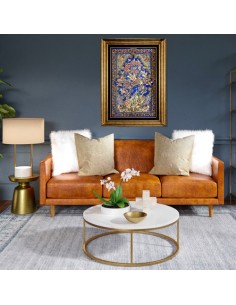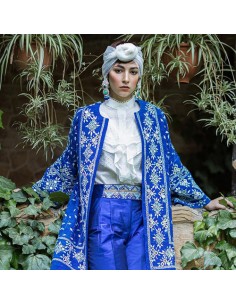- Mahsa S. Y.
- News
- 15612 views
- 16 comments
In 1669, the word "Persian blue" officially entered English reference books as a color name. Generally, this color is known and used in art as Persian blue and in medical and chemical sciences as Prussian blue. This article intends to introduce the Iranian blue color, the color spectrum of this family of blue, and its applications in Iranian art.
The history of Iranian art and architecture, the old buildings, and antiquities discovered by archaeologists show that a particular range of blue has always been used in Iranian handicrafts and architecture, from antiquity to post-Islamic history. The number of antiquities found with this blue color was so much that it made the world call this color Persian or Iranian blue. The world knows the eight colors as "Persian luxury color"; Persian blue is the most popular among them.
An excellent example of this color in nature is the color of the lapis lazuli stone. Lapis lazuli has an attractive deep blue color similar to Persian blue.
The Persian or Iranian blue color spectrum starts from turquoise to azure. It has three main subgroups:
- Ordinary Persian Blue
- Azure Persian Blue
- Turquoise Persian Blue
The color code of which is as follows:

Which Color is Persian Blue?
The Persian blue color code is 1C39BB, a shade near navy blue. Still, the world knows three colors as Iranian or Persian blue: the ordinary one known as Persian blue (1C39BB), Azure Persian blue (0067A5), and Turquoise Persian blue (57C5C6).
As mentioned earlier, and it's evident in our handicraft products, Iranian blue has various applications in Iranian art and architecture. Some ancient Iranian heritages that nowadays are in the United States, Canada, and European countries are in this color, so you probably have seen them. For example, the picture below shows three Iran heritages in the museums of the USA. In the following, we will introduce some of the Persian blue color's applications in Iranian art from ancient till now:

Persian Blue in Iranian Architecture
If you have ever traveled to Iran, definitely visiting the historical monuments, the Iranian blue color has attracted the attention of your eyes.
But you have yet to have the opportunity to travel to Iran. In that case, you can visit the extraordinary works of Iranian architects with a simple web search. In addition to enjoying the artistic wonders of ancient Iranian and Iranian-Islamic architectural styles, you can see the Persian blue's place in this field.
Here is a complete overview of Iranian architecture, including its features, styles, history, and various samples with pictures for whoever wants to know more.
Iranian Blue in Interior Architecture
In addition to exterior architecture, the Iranian blue color has a special place in interior architecture. For example, in most Iranian mosques, the ceiling and most of the interior walls are painted with detailed and dazzling patterns, of which Iranian blue is one of the primary colors used.
According to historians, one of the most important reasons for the use of blue in the interior architecture of the building is that this color gives the viewer a sense of calm and liberation. Religious buildings are places that most people visit to express their minds and souls, so Iranian architects were aware from the beginning that they should use soothing colors in painting these buildings to achieve this goal. What color is better than Iranian blue?

Persian Blue in Artistic Handicrafts
Iranian handicrafts include a diverse and extensive collection that includes enameling, pottery, engraving, turquoise, engraving, carpets and kilims, woodcarving, mosaics, and many more. Persian blue color has many applications in many of these industries. For example, consider the following:
- Pottery: Blue is the primary color used in the pottery industry. In fact, in the beginning, the only color used for pottery glazing was blue, and over time, other colors have opened their way to this art industry.

Cyrus Crafts; Luxury & Unique Products
- Turquoise: Turquoise is the name of a beautiful and precious mineral found in some regions with dry climates, such as Iran. One of the best types of turquoise in the world is extracted from Iranian mines, and it has a beautiful color; this turquoise color is also in the range of Persian blue. Iranians have been making turquoise handicrafts and accessories since ancient times.

- Enameling: Enameling is one of the most delicate and detailed branches of art as enameling handicrafts or accessories. The enamel artist delicately combines patterns full of details with beautiful colors. One of the most widely used colors in this art is Iranian blue.

- Glassware: Glassware is another Iranian handicraft in which the artist makes utensils with a glass of different colors. This art is characterized by a variety of colors in the glass used. Iranian blue is also trendy and used in the art of glass.
Miniature Painting and Persian Blue
Miniature is a term that has entered the Persian language in recent centuries and refers to the style of Iranian painting, which has a much older background. Today, all Iranian paintings that do not show any trace of non-Iranian styles are called miniature paintings. The Iranian blue color was initially in the Iranian miniature painting style. This color still has a special place in the works of miniature artists.

Iranian Blue in Fashion and Clothing
Iranians have long paid particular attention to the beauty of their clothing and have used many arts in this field. For example, the art of Termeh, used to print designs and patterns on fabric, or the art of needlework, in which the artist embroiders original designs delicately, all include several examples in Iranian blue. In addition, blue is one of the most popular colors for clothing fabrics.
Many celebrities worldwide wear Persian blue costumes. For example, in the following photo, you see Nazanin Bonyadi, the Iranian actress, producer, and activist committed to human rights in the United States of America, Rachel McAdams, and Ryan Gosling, an actress and actor from Canada in this lovely color dresses and suit.

Moreover, India is a neighbor of Iran, so Iranian blue has always been used in Indian costumes like sarees. In addition to Indian costumes, Indians use this color in their accessories; for example, lapis lazuli earrings and bracelets are trendy in India.
Persian Blue Salt
One of the purest salts in the world is Persian blue salt. This unique salt has health benefits, such as controlling blood pressure and caring for the cardiovascular system. Persian blue salt is found only in Semnan city's mountains, which is rare. In the following, you see two zoomed-in pictures of Persian blue salt with every single detail. They look fantastic.


As you can see, the Iranian blue color has long had a special place in the daily life of Iranians, which is why the world has given it the Iranian name. In addition to Persian blue, seven other colors are known as Iranian in world reference books: Persian green, medium Persian blue, Persian Indigo, Persian pink, Persian red, Persian Plume, and Persian orange.
Meanwhile, Iran's azure and indigo colors, which are somehow in the blue spectrum due to their similarity and proximity to the Iranian blue color, are usually called Iranian blue.

Persian Blue Color Summary
What you just read was a brief introduction to one of the most famous Persian colors, Persian blue. CyrusCrafts is proud to tell you that we have collected a perfect collection of Iranian handmade rugs, furniture, costumes, handicrafts, and accessories. You can order easily by filling out their order forms at the best prices worldwide.
Our colleagues deliver your orders to your door within a short time, and this time would be shorter if you live in Canada or the United States. Some of our products are in beautiful Iranian blue, which you can see in the article's related products.
What is your opinion? Could you share it with us in the comments?
What is your opinion about these colors with Iranian identity?




















Comments (16)